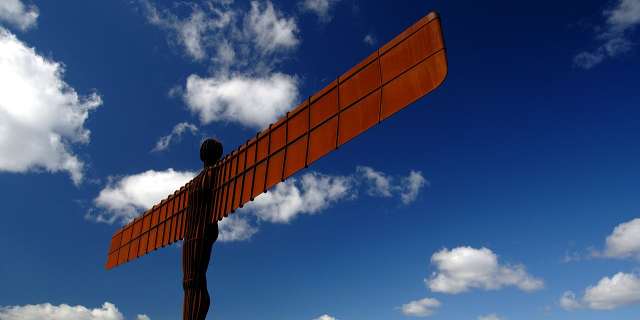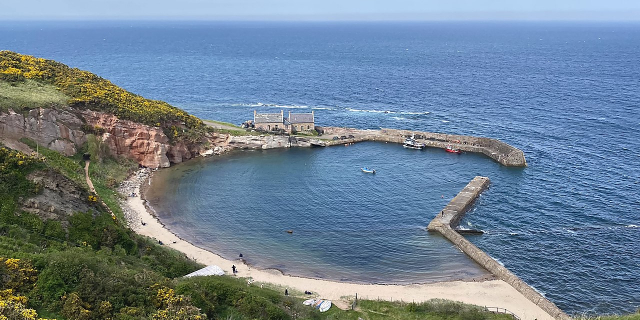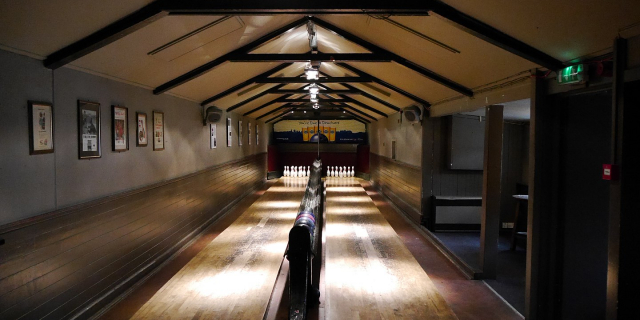Alnwick Castle ( ) is a castle and country house in Alnwick in the English county of Northumberland. It is the seat of the 12th Duke of Northumberland, built following the Norman conquest and renovated and remodelled a number of times. It is a Grade I listed building now the home of Ralph Percy, 12th Duke of Northumberland and his family. In 2016, the castle received over 600,000 visitors per year when combined with adjacent attraction the Alnwick Garden.
 Isometric view of Alnwick Castle, 1866
Isometric view of Alnwick Castle, 1866 Alnwick Castle, chromolithograph by Alexander Francis Lydon, 1870
Alnwick Castle, chromolithograph by Alexander Francis Lydon, 1870 Alnwick Castle, the altar in the castle Chapel
Alnwick Castle, the altar in the castle ChapelAlnwick Castle guards a road crossing the River Aln.[1] Ivo de Vesci, Baron of Alnwick, erected the first parts of the castle in about 1096.[2] Beatrix de Vesci, the daughter of Yves de Vescy, married the Constable of Chestershire and Knaresborough, Eustace fitz John. By his marriage to Beatrix de Vesci he gained the baronies of Malton and Alnwick. The castle was first mentioned in 1136 when it was captured by King David I of Scotland.[3] At this point it was described as "very strong".[1] It was besieged in 1172 and again in 1174 by William the Lion, King of Scotland and William was captured outside the walls during the Battle of Alnwick.[4] Eustace de Vesci, lord of Alnwick, was accused of plotting with Robert Fitzwalter against King John in 1212.[5] In response, John ordered the demolition of Alnwick Castle and the demolition of Fitzwalter's stronghold, Baynard's Castle,[6] though his instructions were not carried out at Alnwick.[7]
The castle had been founded in the late 11th century by Ivo de Vesci, a Norman nobleman from Vassy, Calvados in Normandy. A descendant of Ivo de Vesci, John de Vesci, succeeded to his father's titles and estates upon his father's death in Gascony in 1253. These included the barony of Alnwick and a large property in Northumberland and considerable estates in Yorkshire, including Malton. As John was underage, King Henry III of England conferred the wardship of his estates to a foreign kinsman, which caused great offence to the de Vesci family. The family's property and estates had been put into the guardianship of Antony Bek, who sold them to the Percys. From this time the fortunes of the Percys, though they still held their Yorkshire lands and titles, were linked permanently with Alnwick and its castle and have been owned by the Percy family, the earls and later dukes of Northumberland since.[8] The stone castle Henry Percy bought was a modest affair, but he immediately began rebuilding. Though he did not live to see its completion, the construction programme turned Alnwick into a major fortress along the Anglo-Scottish border. His son, also called Henry (1299–1352), continued the building.[9] The Abbot's Tower, the Middle Gateway and the Constable's Tower survive from this period.[8] The work at Alnwick Castle balanced military requirements with the family's residential needs. It set the template for castle renovations in the 14th century in northern England; several palace-fortresses, considered "extensive, opulent [and] theatrical" date from this period in the region, such as the castles of Bamburgh and Raby.[10] In 1345 the Percys acquired Warkworth Castle, also in Northumberland. Though Alnwick was considered more prestigious, Warkworth became the family's preferred residence.[11]
The Percy family were powerful lords in northern England. Henry Percy, 1st Earl of Northumberland (1341–1408), rebelled against King Richard II and helped dethrone him. The earl and his son Harry Hotspur later rebelled against King Henry IV and after defeating Hotspur in the Battle of Shrewsbury, the king pursued the earl. The castle surrendered under the threat of bombardment in 1403.[12]
 Alnwick Castle, by J. M. W. Turner
Alnwick Castle, by J. M. W. TurnerDuring the Wars of the Roses, castles were infrequently attacked and conflict was generally based around combat in the field. Alnwick was one of three castles held by Lancastrian forces in 1461 and 1462, and it was there that the "only practical defence of a private castle" was made according to military historian D. J. Cathcart King.[13] It was held against King Edward IV until its surrender in mid-September 1461 after the Battle of Towton. Re-captured by Sir William Tailboys, during the winter it was surrendered by him to Hastings, Sir John Howard and Sir Ralph Grey of Heton in late July 1462. Grey was appointed captain but surrendered after a sharp siege in the early autumn. King Edward responded with vigour and when the Earl of Warwick arrived in November Queen Margaret and her French advisor, Pierre de Brézé, were forced to sail to Scotland for help. They organised a mainly Scots relief force which, under George Douglas, 4th Earl of Angus and de Brézé, set out on 22 November. Warwick's army, commanded by the experienced Earl of Kent and the recently pardoned Lord Scales, prevented news getting through to the starving garrisons. As a result, the nearby Bamburgh and Dunstanburgh castles soon agreed terms and surrendered but Hungerford and Whittingham held Alnwick until Warwick was forced to withdraw when de Brézé and Angus arrived on 5 January 1463.
The Lancastrians missed a chance to bring Warwick to battle instead being content to retire, leaving behind only a token force which surrendered the next day. By May 1463 Alnwick was in Lancastrian hands for the third time since Towton, betrayed by Grey of Heton who tricked the commander, Sir John Astley. Astley was imprisoned and Hungerford resumed command. After Montagu's triumphs at Hedgeley Moor and Hexham in 1464 Warwick arrived before Alnwick on 23 June and received its surrender next day. By the following decade, the 4th Earl of Northumberland had pledged fealty to Edward IV and the castle was returned to the Percys.
After the execution of Thomas Percy, 7th Earl of Northumberland, in 1572 Alnwick Castle was increasingly uninhabited.[9] The 9th Earl of Northumberland placed his distant cousin, another Thomas, in charge as constable in 1594, but just over a decade later Thomas was killed fleeing the Gunpowder Plot and the earl was imprisoned in the Tower of London, beginning over a century without a significant Percy presence at Alnwick. In 1650, Oliver Cromwell would use the castle to house prisoners following the Battle of Dunbar.
In the second half of the 18th century Robert Adam carried out many alterations, as did James Paine, Daniel Garrett and Capability Brown, all under the orders of the returning Percy family. Elizabeth Seymour and Hugh Smithson were elevated to 1st Duke and Duchess of Northumberland in 1766 by George III, whose restorations at Windsor Castle were partly inspired by the couple's work at Alnwick. The interiors were largely in a Strawberry Hill gothic style not at all typical of Adam's work, which was usually neoclassical, as seen at the Northumberlands' London home, Syon House.
However, in the 19th century Algernon, 4th Duke of Northumberland replaced much of Adam's architecture. Instead, he paid Anthony Salvin £250,000 between 1854 and 1865 to remove the Gothic additions and other architectural work. Salvin is mostly responsible for the kitchen, the Prudhoe Tower, the palatial accommodation and the layout of the inner ward.[14] Some of Adam's work survives, but little or none of it remains in the principal rooms shown to the public, which were redecorated in an opulent Italianate style in the Victorian era by Luigi Canina.


































Add new comment